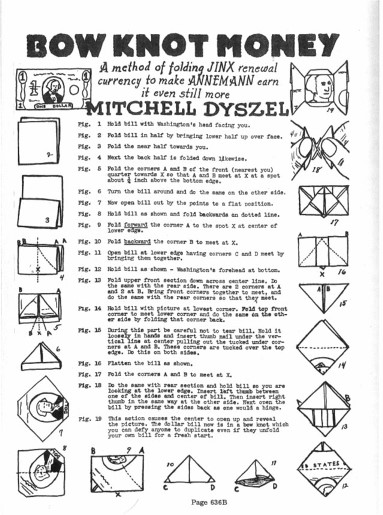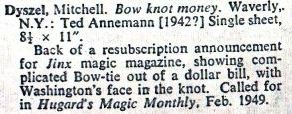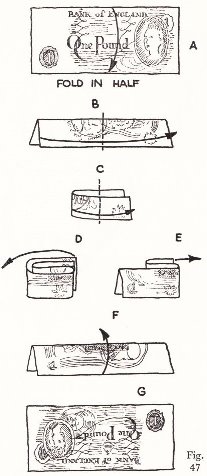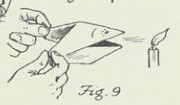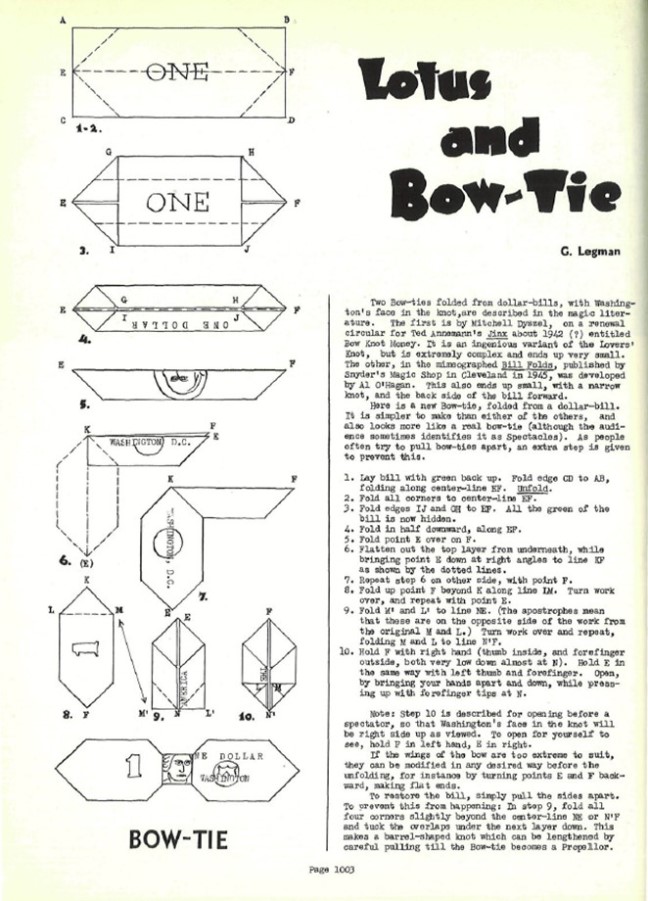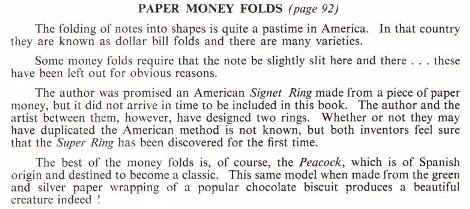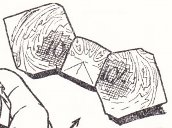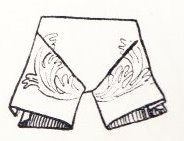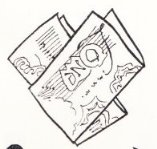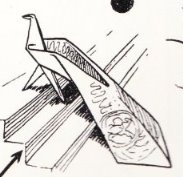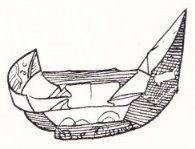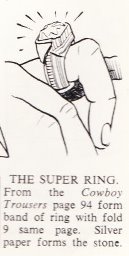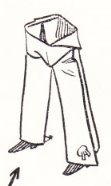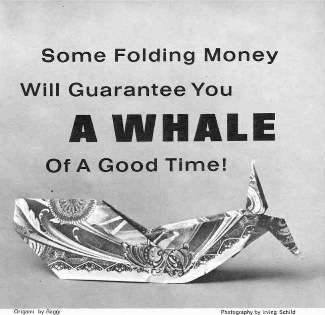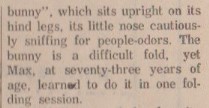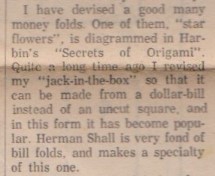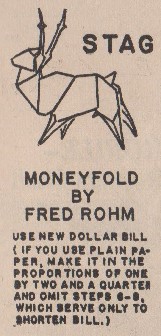| The Public Paperfolding History Project
Last updated 26/4/2025 x |
|||||||
| Money Folding / Dollar Bill Folding | |||||||
| Thids
page attempts to collect together what is known about the
history Money Folding, the folding of paper money. The folding of paper money can be divided into three categories, magical effects which revolve around the value of the money being folded, designs which just make use of the shape of paper money as a useful starting point, and designs which make use of parts of the pictures or lettering, or both, printed on paper money to create a specific effect within the design. I have not, at present, differentiated these three types of money folding on this page, not have I differentiated between the use of various currencies as folding material. ********** 1930s 'The Best of Origami: New Models by Contemporary Folders' by Samuel Randlett, which was published by E P Dutton in New York in 1963 and by Faber and Faber Ltd in London in 1964 contains a Preface by Martin Gardner which says:
I have not been able to independently verify this information or identify the design in question. ********** 1940 Diagrams for a design called 'Bow Knot Money' (an adaptation by Mitchell Dyszel of the Lover's Knot from a dollar bill which places Washington's face in the knot) were published in 1940 in the magic magazine 'The Jinx' no 106 on page 636B (the rear of a resubscription advert). Information from Edwin Corrie. Gershon Legman's 'Bibliography of Paper-Folding' incorrectly suggested that publication was in 1942. (In fact 'The Jinx' ceased publication in December 1941.)
********** Issue 122, p711,of 'The Jinx', also published in 1940, contained details of 'Double Dollar', an effect by Jack Vosburgh in which a dollar bill is folded so that it looks like two bills, then is shown to actually have become two separate bills.(Information from conjuringarchive.com) ********** How to Turn a Bank Note Upside Down - 1941 onwards
********** 1945 A leaflet called 'Bill Folds' by Al O'Hagan was issued by George Snyder's Magic Shop of Cleveland, Ohio in 1945. ********** 1949 Hugard's Magic Monthly for February 1949 contained an article about money folding by Martin Gardner explaining the Mazuma Fish, Mazuma Midget and Mazuma Mushroom folds. (Mazuma is US slang for money.)
********** Hugard's Magic Monthly for April 1949 contained diagrams for two dollar bill folds by Orville Meyer, 'Panties' and 'Two for One'
********** 'Over the Coffee Cups' by Martin Gardner was published by the Montandon Magic Co in 1949. It contains 'Gal, Legal and Private', a stunt in which a dollar bill is folded to create these words, Berland's Vanishing Bill in which a dollar bill folded to simulate two bills is opened to show only one, and several other curious items using folded dollar bills. ********** 1952 Gershon Legman's dollar bill fold 'Lotus and Bow-Tie' appeared in 'The Phoenix' issue 251 of March 21st 1952, together with a discussion of the various forms of Bow-Tie designs then known. Information from Edwin Corrie.
********** 1956 'Paper Magic' by Robert Harbin, which was published by Oldbourne in London in 1956, contains eight designs intended to be folded from paper money and the information that:
The Bow Tie - folded from a ten shilling note (or a dollar)
*** Pair of Shorts (from a banknote). Attributed to Orville Meyer, U.S.A.
In the original version Washingtons' eye appears in the crotch. Source: David Lister on The Origin Of Paper Money Folding quoting information in Gershon Legman's 'A Bibliography of Paperfolding'. *** The Double Note. Attributed to Will Goldston
*********** The Peacock (from a banknote)
*** Pound Note Barge (a version of the Chinese Junk folded from a pound note)
*** The Diamond Ring (from a banknote). By Robert Harbin with Rolf Harris.
*** The Super Ring (from a banknote). By Robert Harbin with Rolf Harris.
*** The Cowboy Trousers (from a banknote). By Rolf Harris.
********** 1958 On 27th April 1958 The Star Magazine, the Sunday supplement of the Washington Evening Star newspaper, published an article featuring Yoshizawa which pictures designs he has created from paper money. The article gives no context about how it came to be sourced or published. *********** Volume 1, Issue 2 of 'The Origamian', which was published in November 1958, in giving an account of a meeting on the afternoon of 3rd November, mentions that 'We ... learned some dollar bill folds' but does not say what folds these were or who taught them. ********** Volume 1, Issue 3 of 'The Origamian', which was published in December 1958 contains information about the money folding practised by the magician Victor Frenkl:
********** 1959 Volume 1, Issue 4 of 'The Origamian', which was published in January 1959, contains a description of Vicor Frenkil's efforts to fold a five-pointed star from a dollar bill. *** Volume 1, Issue 5 of 'The Origamian', which was published in January 1959, mentions that 'Miss Millar made the word ORIGAMI pasted on a board - - each letter folded like Mr. Frenkil's dollar bill folds.' ********** The Dollar Bill Boot - 1961 onwards
********** 1964 An article in the Cape Girardeau 'Bulletin' of 17th September 1964 reports on an exhibition of 'money sculpturing' at the First National Bank of Cape Girardeau, which it says is the property of NAMCO. ********** 1963 Publication of 'The Folding Money Book' by Adolfo Cerceda. The introduction to the second part says, inter alia:
********** 1967/8 Issues 110 of April 1967 to 115 and 117 to 121 of September 1968 of MAD Magazine included adverts for subscriptions to the magazine featuring origami designs folded from dollar bills. These designs were folded by, and in most cases probably also designed by, Giuseppi Baggi.
********** 1968 Publication of 'Folding Money, Volume Two' edited by Samuel Randlett, which was published by Magic Inc of Chicago in 1968. Inter alia this work contains information about the Gift Shop of money related items set up by William King, of the Hagerstown Trust bank within the bank premises (some of which involved folding dollar bills), designs by Victor Frenkl (alphabet, numbers, monograms and words of upo top 5 letters), Neal Elias, John Nordquist and Robert Neale. There are also three unattributed designs: Necktie - a two-piece design.
*** Small Bill - a dollar bill folded down to a smaller size so that it retains the main features of the original.
*** Bikini Trunks
********** 1969 Vol 9: Issue 1 of 'The Origamian' for Spring 1969 contained an article 'On Money Folds', written by Fred Rohm, some paragraphs of which contain interesting historical information:
The reference to 'Star Flowers' being published in 'Secrets of Origami' is incorrect. It was in fact published in 'The Best of Origami' by Samuel Randlett. Thesame issue also contained a review of 'Folding Money Volume 2' by Samuel Randlett and diagrams for a Stag (from a dollar bill) by Fred Rohm.
********** |
|||||||

